How to Grow Durban Poison Strain
Durban Poison: the name alone incites curiosity, doesn’t it? Hailing from African landrace sativa genetics, this unique cannabis strain has captivated smokers and growers alike with its 100% sativa lineage.
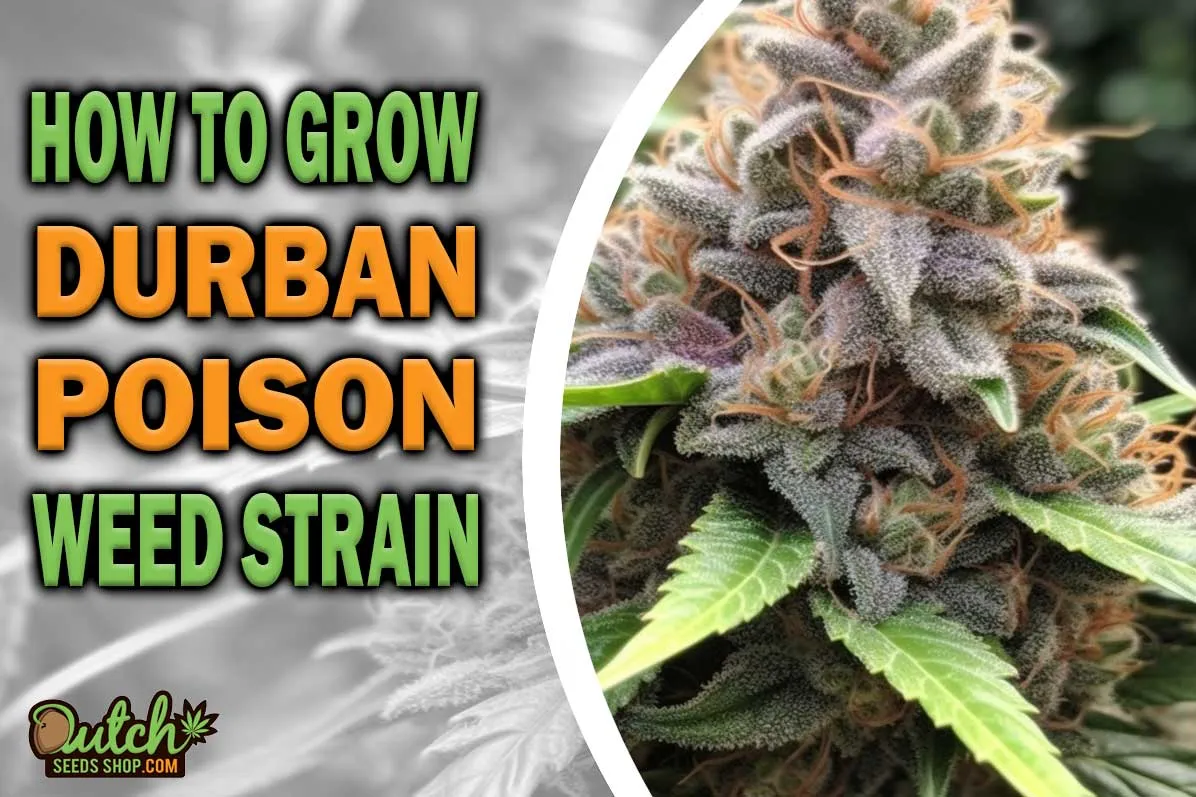
Get To Know Durban Poison Strain
A classic, Durban Poison strain has roots that are as pure sativa as they come.
With parents native to Africa, it gives you a taste of exotic lineage.
The effects are energetic, focused, and uplifted, making it a favorite among daytime users.
Earthy, piney, and sweet flavors enchant the palate.
When it comes to popularity, the Durban Poison strain has got a cult following, with high praise in reviews, and mesmerizing pictures and videos of the lush, green plants and crystal-coated buds.
Tips and Tricks for Growing Durban Poison Successfully
From seed to harvest, growing Durban Poison seeds is quite the adventure. Here are some quick tips:
- Consider the Growth Stages: Expect a flowering time of 56 to 63 days.
- Difficulty: Fortunately, the grow difficulty is easy, making it perfect for both novice and expert cultivators.
- Seed or Clone: Both options work well, so choose based on your level of expertise.
- Accessories: Have essential cultivation accessories like quality soil, LED grow lights, and a good nutrient solution handy.
Durban Poison Indoor Growing
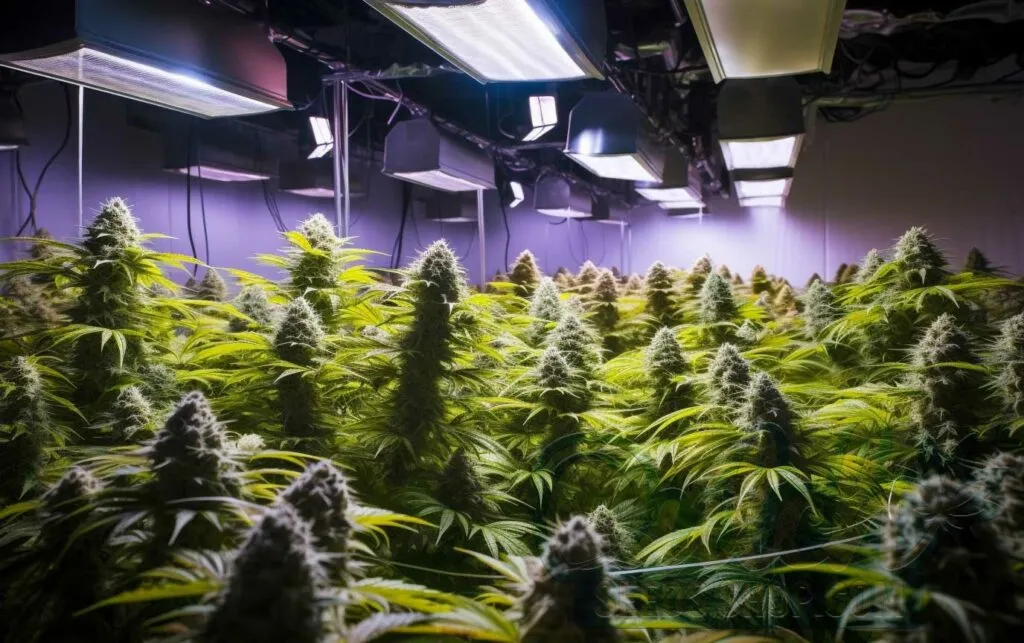
Time to zoom in on the indoor cultivation of Durban Poison.
This strain’s natural resilience and medium height make it perfect for controlled environments, setting you up for a verdant indoor cannabis garden that’s less about stress and more about success.
Benefits of Indoor Growing
Indoor growing offers you a cannabis playground where you can manipulate every factor to dial in the optimal conditions for your Durban Poison plants.
You’re not at the mercy of Mother Nature, so no unexpected frost or heatwaves to spoil your harvest.
You’ll also find that indoor conditions often lead to more aromatic, potent buds, thanks to your ability to control light exposure, nutrients, and airflow.
| Benefits of Indoor Growing | Description |
| Climate Control | Full control over temperature and humidity, leading to a better quality harvest. |
| Multiple Harvests | The ability to grow year-round. |
| Pest Management | Easier to manage pests and diseases. |
| Privacy | Indoor growing is discreet, keeping your activities low-key. |
| Quality of Bud | More control means potentially more potent, aromatic cannabis. |
Setting Up Your Indoor Grow Space
Creating the perfect space for your Durban Poison plants is an art form in itself.
Whether you’re working with a spare room or a grow tent, planning ahead pays off.
Account for ventilation, lights, and other accessories.
With Durban Poison, you’re working with a medium-height plant, so space shouldn’t be an issue.
Calculate the square footage you’ll need and make sure you have adequate electrical outlets to support your lighting and climate control systems.
- Space Selection: Choose between a spare room, closet, or tent.
- Ventilation: Install inline fans and air filters.
- Lights: Position lights at optimal distances from plants.
- Accessories: Make room for humidifiers, dehumidifiers, and nutrient tanks.
Climate Control
Climate plays a pivotal role in the success of your Durban Poison grow.
These plants prefer a mild climate with temperatures ranging between 70–80°F.
A hygrometer can help you measure both temperature and humidity, while oscillating fans can keep the air moving, preventing mold and strengthening your plants.
Temperature fluctuations can stress plants, leading to hermaphroditism, so avoid sudden changes.
Automate your climate settings if possible, using smart plugs or timers connected to your AC, heater, and fans.
Dehumidifiers are essential for controlling moisture levels, especially during the flowering stage.
Types of Lights
Picking the perfect lights is no small feat.
LED grow lights are fantastic for long-term savings and efficiency, while High-Intensity Discharge (HID) lights offer strong output for larger operations.
Durban Poison, being a sativa, requires a lot of light – particularly during the vegetative stage.
Adjustable spectrum LEDs can be switched to match the plant’s light requirements throughout its lifecycle.
| Type of Lights | Pros | Cons |
| LED | Energy-efficient, low heat. | Initial cost is high. |
| HID | High light output. | Heat output, costly. |
| Fluorescent | Low heat, cheap. | Less efficient. |
Growing Mediums and Containers
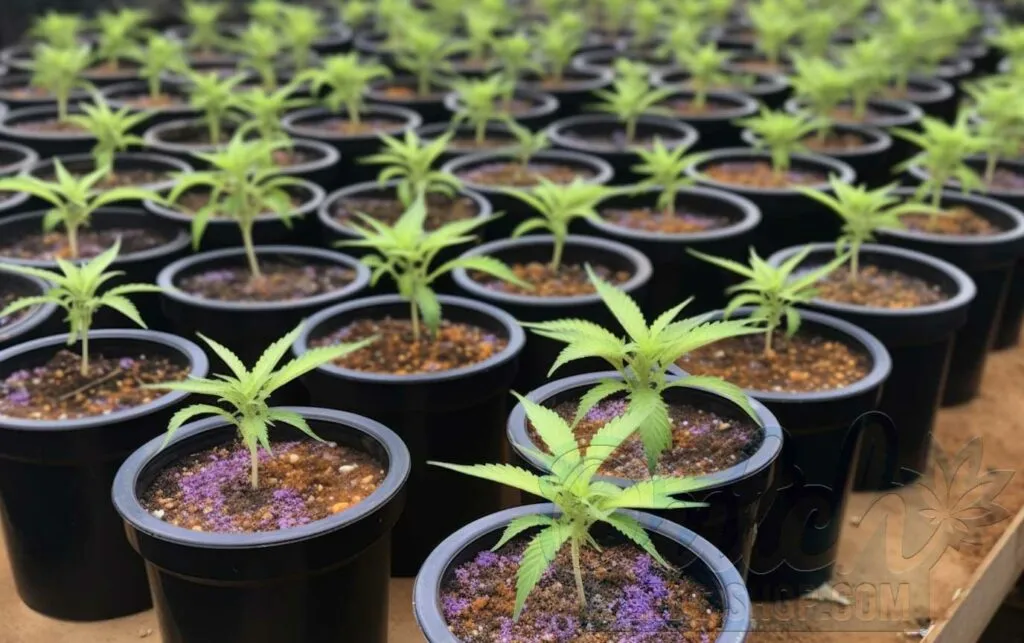
Selecting the right medium and container is like choosing the fabric for a master painting.
Soil, the traditional go-to, is rich in nutrients and offers a buffer against pH imbalances.
The hydroponic systems, on the other hand, provide an environment where you have the ultimate control over nutrient delivery, but it’s less forgiving of mistakes.
For containers, fabric pots offer superior aeration, but require frequent watering.
Plastic pots are budget-friendly but may need holes drilled for better drainage.
Be it soil, coco coir, or hydroponics, always ensure that your medium provides excellent drainage and nutrient retention.
Calcium and magnesium supplements are often needed, particularly when growing in coco coir or hydroponic systems.
Caring for Indoor-Grown Durban Poison
Post-setup, it’s all about the upkeep.
Durban Poison plants need consistent watering with pH-balanced liquid, hovering around 6.0 for soil and 5.8 for hydroponics.
Use nutrient solutions optimized for cannabis to keep the Nitrogen-Phosphorus-Potassium (NPK) levels balanced.
Watch out for nutrient burn, evident by yellowing tips on the leaves.
- Water: Use pH-balanced water, adjust according to medium.
- Nutrients: Employ a balanced NPK fertilizer.
- Inspection: Regularly check for signs of diseases and pests.
- Pruning: Remove dead leaves and low-lying branches for better airflow.
Odor Control
One of the most challenging aspects of indoor growing is managing the intense aroma that Durban Poison plants can produce.
While the scent might be heavenly to you, it might not be for your neighbors.
Carbon filters are the most effective at trapping odors.
Attach them to your exhaust fan for best results.
Ozone generators are another option, but they can be hazardous to pets and should be used cautiously.
Negative ion generators can neutralize some smells but are generally less effective.
Always ensure adequate ventilation to disperse any lingering odors.
Sealing the room can also prevent odors from escaping, but this can make climate control more challenging.
Durban Poison Outdoor Growing
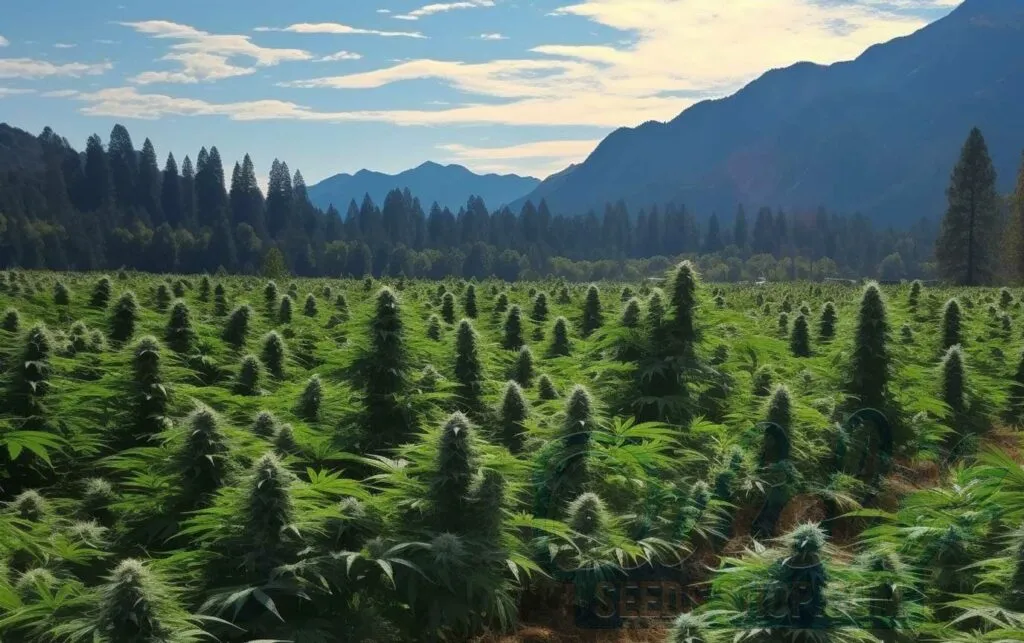
Shift the lens to outdoor cultivation of Durban Poison, where natural sunlight and soil nutrients could give your plants that unique, earthy kick.
If you’re all about that farm-to-table – or in this case, farm-to-joint – experience, then listen up!
Benefits of Outdoor Growing
Going the outdoor route isn’t just about letting Mother Nature take the wheel.
Outdoor cultivation is often less expensive, eliminating the cost of lights, fans, and electricity.
Also, you can often yield larger plants because they have plenty of space to stretch out and grow.
The full spectrum of natural sunlight can lead to robust, flavorful buds.
Plus, there’s something to be said about the simplicity and purity of growing plants outdoors, as nature intended.
| Benefits of Outdoor Growing | Description |
| Cost-Efficiency | No need for electrical setup. |
| Higher Yields | More space for growth. |
| Natural Spectrum | Sunlight enriches plant quality. |
| Sustainability | Less equipment, less waste. |
| Simple Setup | No need for complex systems. |
Best Time to Plant Durban Poison Outdoors
Durban Poison plants love the great outdoors, but timing is everything.
In the Northern Hemisphere, the ideal planting time is between April and May.
This sativa-dominant strain needs a full season to develop its aromatic buds.
In Southern latitudes, the planting window shifts to September to October.
Avoid frost at all costs, as it can damage your plants and ruin your yield.
- Northern Hemisphere: April to May
- Southern Hemisphere: September to October
- Tropical Climates: Year-round planting possible
- Avoid Frost: Crucial for plant health
Setting Up Outdoor Grow Spaces
Location, location, location – it’s not just a mantra for real estate.
Your plants need a spot with at least eight hours of direct sunlight.
Make sure to account for natural windbreakers like fences or shrubs.
Drainage is critical; nobody wants a waterlogged cannabis garden.
You’ll also want to consider privacy and security, maybe install a discreet fence or camouflaging plants.
Durban Poison tends to grow tall, so have stakes or cages ready to support them.
- Sun Exposure: At least 8 hours of direct sunlight
- Windbreakers: Natural or artificial
- Drainage: Essential for plant health
- Security: Discreet fences or camouflage
- Support: Stakes and cages
Selecting and Preparing Soil
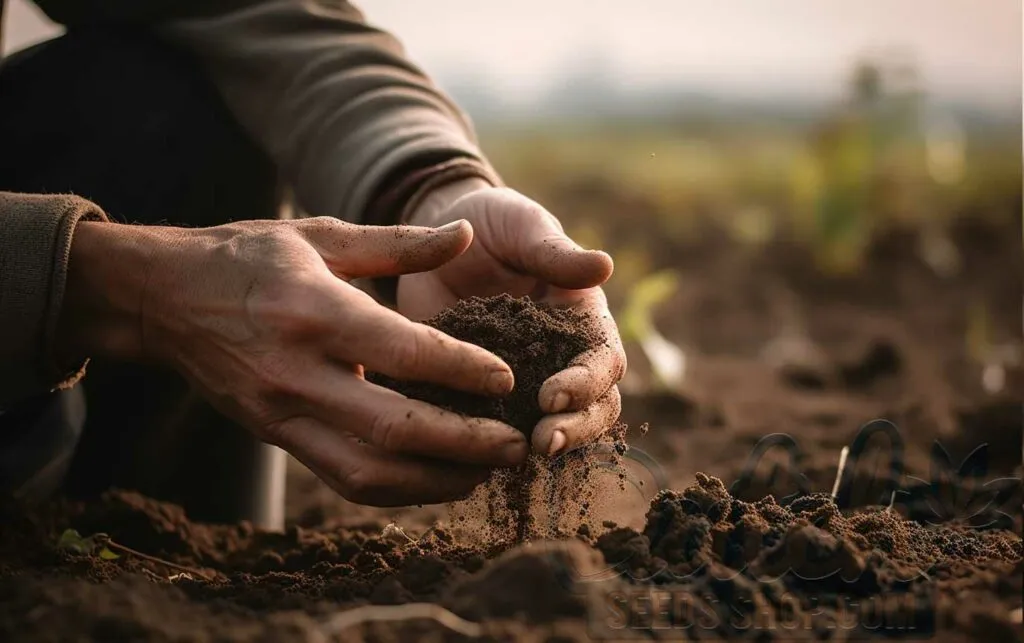
Soil is like the magic carpet for your Durban Poison plants – it can either take them soaring or leave them grounded.
You want a well-aerated medium that drains well but retains moisture.
Soil pH should be between 6.0 and 7.0.
Organic soil enriched with compost can provide most of the necessary nutrients.
However, for optimal yields, consider supplementing with organic fertilizers like bat guano or bone meal.
Tilling the soil and adding perlite or sand can improve drainage.
Don’t overlook the magic of earthworms, which can naturally aerate the soil and aid in breaking down organic matter.
Test the soil before planting and adjust as needed.
Nutrients and Fertilizers
Feed those hungry Durban Poison plants right, and they’ll treat you to some of the most potent buds you’ll ever experience.
Focus on nitrogen-heavy fertilizers during the vegetative stage and phosphorus and potassium during flowering.
Overfeeding can lead to nutrient burn, so always start with half of the recommended dosage and work your way up.
| Nutrient Stage | Recommended Fertilizers | N-P-K Ratio |
| Vegetative | Fish Emulsion, Bat Guano | High N, Low P, K |
| Flowering | Bone Meal, Bloom Boosters | Low N, High P, K |
How to Maximize Durban Poison Yield
You didn’t get this far just to settle for mediocre results.
To max out those yields, focus on strong light exposure, which Durban Poison craves.
Pruning techniques like topping can help distribute light more evenly across the plant.
Don’t be shy on the nutrients, but keep it balanced to prevent nutrient burn.
Stress training techniques like Low Stress Training (LST) can also increase yields by exposing more bud sites.
Humidity control is equally crucial; keep it higher during vegetative growth and lower during flowering to prevent mold and boost resin production.
- Pruning: Use techniques like topping or fimming.
- Stress Training: LST or Screen of Green (ScrOG).
- Light Exposure: At least 8 hours of direct sunlight.
- Nutrients: Balanced feeding schedule.
- Humidity Control: Adjust according to growth stage.
In the adventurous world of cannabis cultivation, Durban Poison is like the holy grail that keeps growers coming back for more.
From the intricate needs of indoor growing – lighting, climate, the works – to the simplicity yet specificity of outdoor cultivation, this strain is an ever-rewarding puzzle to solve.
The yield? Rich, potent buds that are the stuff of legends.
Mastering Durban Poison isn’t just an exercise in cannabis cultivation; it’s an art form.
Why? Because nailing this strain means you get more than just smokable buds – you get a quality of aroma and flavor that is often unparalleled.
It’s more than just growing; it’s crafting an experience from seed to smoke.
Trust me, the effort you put in? Worth every second.
FAQ
Can Durban Poison plants be topped?
Absolutely, topping is a recommended practice to increase the branching and bushiness of Durban Poison plants.
Is Durban Poison mold-resistant?
Generally, Durban Poison does show some mold resistance, but this isn’t a free pass to ignore humidity control.
What’s the average flowering time for Durban Poison?
Expect about 8 to 9 weeks for indoor grows and a late September to early October harvest for outdoor grows.
Can Durban Poison be grown in hydroponics?
Yes, you can! Hydroponic systems can be a great way to control the nutrient uptake and pH levels, although they can be a bit more complex to manage than soil grows.
Is Durban Poison a good strain for edibles?
Heck yes! The potent THC levels and terpene profile make Durban Poison a fantastic choice for edibles, especially if you’re looking for a sativa kick.
About the Author
Share the Love:
